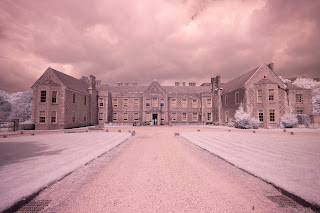According to the Hasselblad web site, “the XPan was an extremely unique camera, providing the advantages of the 35mm format but also the ability to swiftly change to full panorama format without having to change the film. The XPan utilized a dual-format, producing both full panorama 24x65mm format in addition to conventional 24x36mm format on the exact same film. It was the first dual-format 35mm camera on the market that expanded the format instead of masking it, making sure that every exposure utilised the full area of the film.”
Today an XPan (secondhand) kit will set you back over £6000.
In previous posts I discussed how one can digitally simulate an XPan 'sensor', ie create a virtual 65x24mm digital sensor capture, by various pano adapters, with full frame and crop sensor cameras.
The downside, of course, being the need to capture multiple images, then stitch them, risking frame to frame artifacts.
So, the obvious, alternative is to capture single image, in this test case, an IR capture from a converted Canon M10, that runs CHDK and thus one of my Lua scripts, to help with setting infinity focus in microns and an IR based ETTR exposure.
As for focal lengths, shooting at 11mm on the M10 has a similar field of view, within a few degrees, as shooting the XPan with its 30mm lens. Obviously the depth of field will be different, but as I was focusing beyond the hyperfocal this is not an issue.
However, just cropping an M10 single capture to a 617 format is far from emulating an XPan 'negative' of 65x24mm. For example, the digital image would be some 5184 pixels wide, and if we assume an M10 pixel pitch of 4.29 microns, we generate a 22.2mm wide, Canon APS-C, sensor image. Far from the XPan's 65mm film negative.
Of course these days we have technologies that simply didn't exist back in 1998 when the XPan first came out, namely 'software’‘ exploiting advanced ‘AI’ based algorithms.
Thus, as an experiment, I took a handheld, single image, IR capture at 11mm, similar from a FoV perspective to a 30mm XPan capture. The subject being the National Trust's Vyne property.
The RAW capture looked like this:
After undertaking a 180 degree Hue shift in Lightroom, basic correction for exposure and white bslance in Lightroom, and a simple transform for the verticals, I ended up with the following image:
I followed this with a round trip to Photoshop, where I used generative fill to remove some distractions, eg people standing in the entrance area, and fill in the transformed edges. I could have likely accomplished this in Lightroom, but used Photoshop on this occasion.
Back in Lightroom I then cropped to a 617 format, resulting in this image, but still with ‘only’ a 5184 pixel width:
Although the above has the aspect ratio and FoV of a 30mm the Xpan capture, it still has a 'sensor width' of only some 22mm, ie not 65mm.
The last piece of the XPan simulation process is to throw this image at Topaz Photo AI and upscale it to the exact 65mm sensor equivalent, which resulted in this final ‘617 image’, at 15137x5342 pixels:
Of course, I'm kidding myself if I think I’ve created a digital XPan image, for a start I optically shot with an 11mm EF-M lens, and not an XPan 30mm lens, although the field of views are within 4 degrees of each other, ie 94.5 on the 30mm XPan vs 90.5 on the 11mm M10. Also, IMHO, there is no way one can replace the feel, experience and image quality of a film based Xpan capture, by ‘playing around’ with some software. But, on the other hand, I've ‘saved’ myself well over £6000 ;-):-)
As usual I would welcome any feedback on this post or any of my posts.





Just wanted to say how awesome this is. If the gfx cameras were a little more beautiful or hassleblad allowed you to preview in B&W I'd be a happy man shooting xpan. Anyway, keep it up, great stuff!
ReplyDelete